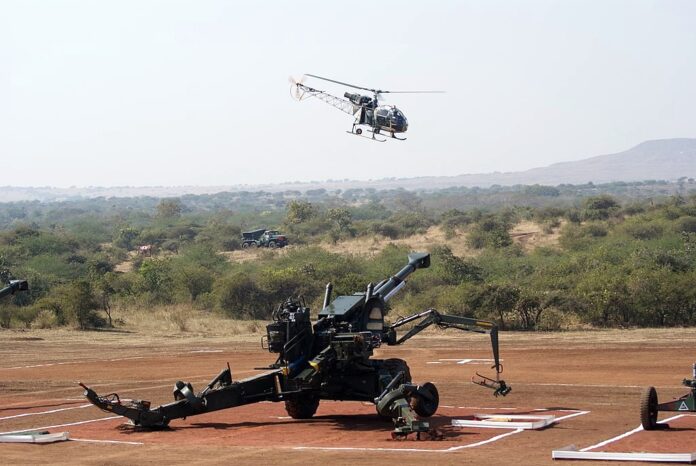India has taken a decisive step towards strengthening its defence capabilities with the approval of military acquisitions worth Rs 61,000 crore. The Defence Acquisition Council (DAC), chaired by Defence Minister Rajnath Singh, has sanctioned procurement projects worth Rs 54,000 crore, while the Cabinet Committee on Security (CCS), led by Prime Minister Narendra Modi, has approved an additional Rs 7,000 crore for indigenous artillery systems.
This dual move is very important for India’s commitment to modernising its armed forces, enhancing indigenous defence production, and reducing reliance on foreign suppliers. With growing security concerns in the Indo-Pacific and along its borders, India is accelerating its military preparedness through a mix of cutting-edge technology acquisitions and strategic procurement reforms.
Upgraded Tanks and Indigenous Artillery
A key component of the DAC’s approval focuses on upgrading the Indian Army’s tank fleet. The procurement includes the purchase of advanced engines for T-90 battle tanks, enhancing mobility, fuel efficiency, and combat endurance. The T-90, a mainstay of India’s armoured formations, will receive state-of-the-art power systems, ensuring a stronger operational presence along key frontiers, particularly the northern and western sectors.
Complementing this is the Rs 7,000 crore CCS-approved acquisition of 307 Advanced Towed Artillery Gun Systems (ATAGS). These 155mm/52-calibre howitzers, developed by the Defence Research and Development Organisation (DRDO), represent a major leap in India’s artillery capabilities. With a strike range of 45–48 kilometres, ATAGS is designed for superior firepower, precision, and rapid deployment.
The production of ATAGS will be spearheaded by Tata Advanced Systems and Bharat Forge, reflecting India’s increasing reliance on private sector participation in defence manufacturing. This shift is a significant step towards self-sufficiency under the ‘Make in India’ initiative, reducing dependence on imported artillery systems.
Advanced Torpedoes for Submarine Warfare
The Indian Navy is set to fortify its underwater combat capabilities with the acquisition of Varunastra heavy-weight torpedoes. These indigenously developed torpedoes, designed by the Naval Science and Technological Laboratory (NSTL) and manufactured by Bharat Dynamics Limited (BDL), will provide enhanced lethality in anti-submarine warfare.
With maritime security concerns escalating in the Indian Ocean Region (IOR) due to China’s growing naval presence, strengthening submarine warfare capabilities is critical for safeguarding India’s maritime interests. The induction of Varunastra torpedoes aligns with India’s broader naval strategy of boosting indigenous deterrence against underwater threats.
AEW&C Aircraft for the Indian Air Force
The Indian Air Force (IAF) will benefit largely from the procurement of Airborne Early Warning and Control (AEW&C) systems. These long-range radar-equipped aircraft act as force multipliers, detecting and tracking enemy aircraft, cruise missiles, and aerial threats long before they enter Indian airspace.
AEW&C aircraft play a pivotal role in network-centric warfare, enhancing India’s aerial superiority. The new acquisitions will strengthen airborne surveillance and early threat detection capabilities, particularly in high-risk zones near the Line of Actual Control (LAC) and the western front.
Reducing Bureaucratic Delays
One of the most critical aspects of the new defence push is the overhaul of India’s procurement process. The Ministry of Defence (MoD) has introduced reforms aimed at cutting down procurement time from 96 weeks to 24 weeks, ensuring faster induction of critical military assets.
By slashing red tape and simplifying approval mechanisms, India aims to accelerate the delivery of advanced weaponry to its armed forces. This shift is essential in addressing emerging security challenges, ensuring that India’s military modernisation keeps pace with its strategic needs.
India’s Road to Defence Self-Sufficiency
The combined Rs 61,000 crore investment signals a paradigm shift in India’s defence strategy, from import dependency to indigenous capability-building. These two developments in a single day are a big leap for the Indian defence industry in many ways.
- Strengthening indigenous manufacturing – Increased reliance on domestic defence firms boosts India’s long-term military preparedness.
- Enhancing combat readiness – Faster procurement means quicker deployment of critical defence assets, reducing vulnerabilities.
- Securing strategic autonomy – Reduced reliance on foreign military suppliers enhances India’s geopolitical leverage.
This massive defence push aligns with India’s long-term goal of achieving self-reliance under the ‘Aatmanirbhar Bharat’ initiative, ensuring that future military acquisitions are driven by domestic expertise rather than foreign procurement dependencies.
This defence investment is not just about acquiring advanced weaponry, it marks a critical transformation in how India builds, deploys, and sustains its military power. The induction of upgraded tank engines, indigenous artillery, advanced torpedoes, and AEW&C aircraft underscores a well-calibrated strategy to fortify India’s defence architecture.
As regional tensions and global power shifts continue to evolve, India’s ability to modernise its military, enhance indigenous production, and streamline procurement processes will define its position as a formidable global defence power. This latest move is a clear signal that India is ready to defend its strategic interests with enhanced self-reliance and cutting-edge military capabilities.



